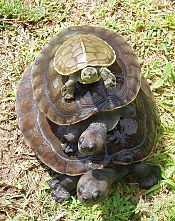Spiny turtle
| Spiny turtle | |
|---|---|
 | |
| Conservation status | |
| Scientific classification | |
| Kingdom: | Animalia |
| Phylum: | Chordata |
| Class: | Sauropsida |
| Order: | Testudines |
| Suborder: | Cryptodira |
| Superfamily: | Testudinoidea |
| Family: | Geoemydidae |
| Genus: | Heosemys |
| Species: | H. spinosa |
| Binomial name | |
| Heosemys spinosa Gray, 1830[1] | |
| Synonyms[3] | |
| |
The spiny turtle (Heosemys spinosa) inhabits lowland and hill rainforest, usually in the vicinity of small streams, mainly in hill areas up to 900 m above sea level.
Description

The origin of its common and specific name is immediately apparent from the sharp, pointed, spiky-edged carapace, and spiny keel, of this unique turtle, also known as the ‘cog-wheel turtle'.
Distribution
The spiny turtle is known from Brunei, Indonesia, Malaysia, Myanmar, the Philippines, Singapore, and Thailand.[1]
Reproduction
Mating behaviour appears to be triggered by rain; in captivity, spraying males with water results in them chasing females and attempting to mount. Nothing is known of nesting behaviour in the wild. One, two, or rarely three eggs are laid per clutch; in captivity, laying usually occurs in the night or early morning. Females produce up to three clutches per year. A plastron hinge develops to ease laying. Three captive incubations have succeeded, with durations of 106, 110, and 145 days.[4]
References
- ↑ 1.0 1.1 1.2 Rhodin 2011, p. 000.190
- ↑ Asian Turtle Trade Working Group (2000). "Heosemys spinosa". IUCN Red List of Threatened Species. Version 2011.2. International Union for Conservation of Nature. Retrieved 29 May 2012.
- ↑ Fritz, Uwe; Peter Havaš (2007). "Checklist of Chelonians of the World". Vertebrate Zoology 57 (2): 224–225. ISSN 18640-5755. Archived from the original on 2010-12-17. Retrieved 29 May 2012.
- ↑ http://www.torontozoo.com/ExploretheZoo/AnimalDetails.asp?pg=694
- Bibliography
- Rhodin, Anders G.J.; van Dijk, Peter Paul; Inverson, John B.; Shaffer, H. Bradley; Roger, Bour (2011-12-31). "Turtles of the world, 2011 update: Annotated checklist of taxonomy, synonymy, distribution and conservation status". Chelonian Research Monographs 5. Archived from the original on 2012-01-22.
- Fritz, Uwe; Havaš, Peter (2007). "Checklist of Chelonians of the World". Vertebrate Zoology 57 (2). Archived from the original on 2010-12-17.
External links
| ||||||||||||||||||||||||||||||||||||||||||||||||||||||||||||||||||||
| ||||||||||||||||||||||||||||||||||||||||||||||||||||||||||||||||||||||||||||||||||||||||||||||||||||||||||||||||||||||||||||

